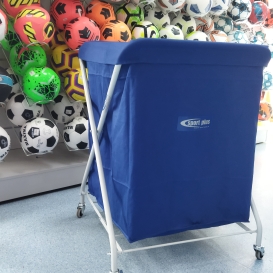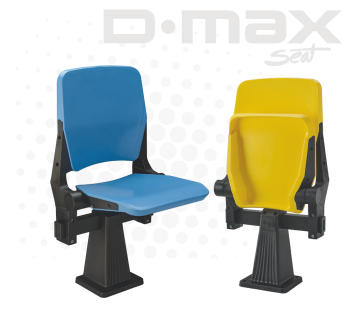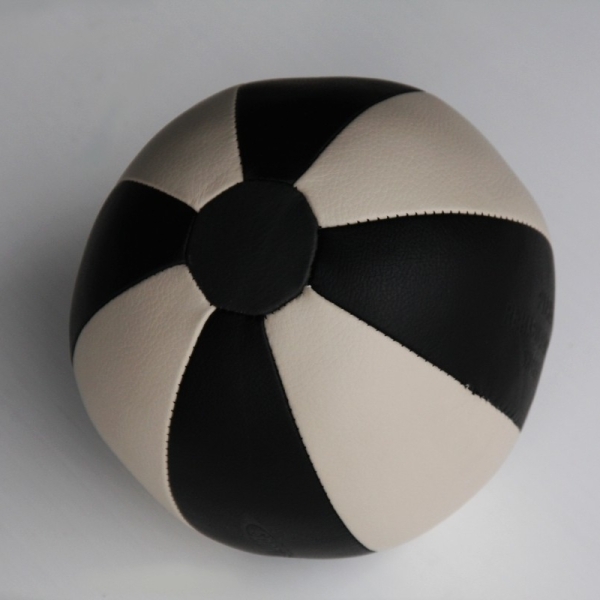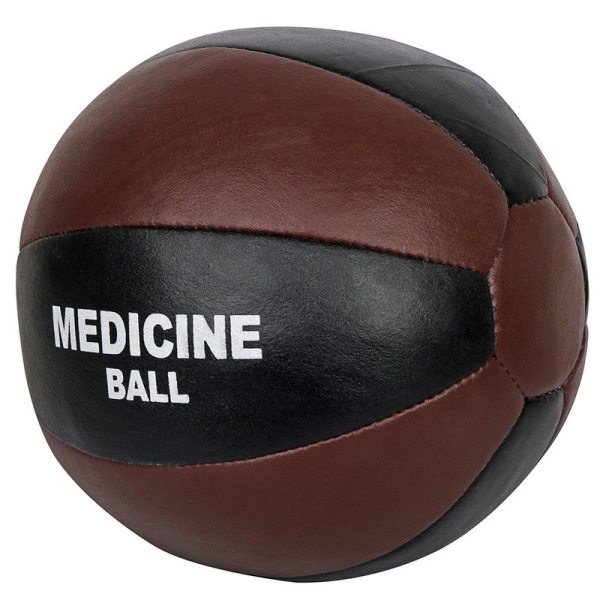Medicine balls
Medicine balls are a valuable component of strength and rehabilitation training. They primarily help improve coordination and endurance. Thanks to their different weights, they allow you to precisely adjust the load to your individual needs. Made of durable materials, they can withstand intensive use, which ensures their longevity. Medicine balls are ideal for use in gyms, schools and during rehabilitation therapies, promoting all-around physical development, effectively strengthening muscles, fitness and fitness.Each throw is a forceful leap forward - why medicine balls?
More useful information can be found at the bottom of the page.-
Medicine ball 1 kg, natural leather
99.63 PLN Tax inc.81.00 PLN NetCatalog no: 70-10024-1
Availability: Delivery within 24-48 hours -
Medicine ball 1 kg, synthetic leather
79.95 PLN Tax inc.65.00 PLN NetCatalog no: 70-10025-1
Availability: Delivery within 24-48 hours -
Medicine ball 2 kg, natural leather
108.98 PLN Tax inc.88.60 PLN NetCatalog no: 70-10024-2
Availability: Delivery within 24-48 hours -
Medicine ball 2 kg, synthetic leather
87.00 PLN Tax inc.70.73 PLN NetCatalog no: 70-10025-2
Availability: Delivery within 24-48 hours -
Medicine ball 3 kg, natural leather
120.54 PLN Tax inc.98.00 PLN NetCatalog no: 70-10024-3
Availability: Delivery within 24-48 hours -
Medicine ball 3 kg, synthetic leather
92.25 PLN Tax inc.75.00 PLN NetCatalog no: 70-10025-3
Availability: Made to order -
Medicine ball 4 kg, natural leather
140.22 PLN Tax inc.114.00 PLN NetCatalog no: 70-10024-4
Availability: Delivery within 24-48 hours -
Medicine ball 4 kg, synthetic leather
103.32 PLN Tax inc.84.00 PLN NetCatalog no: 70-10025-4
Availability: Made to order -
Medicine ball 5 kg, natural leather
162.61 PLN Tax inc.132.20 PLN NetCatalog no: 70-10024-5
Availability: Delivery within 24-48 hours -
Medicine ball 5 kg, synthetic leather
114.39 PLN Tax inc.93.00 PLN NetCatalog no: 70-10025-5
Availability: Made to order -
Medicine ball 6 kg, synthetic leather
112.00 PLN Tax inc.91.06 PLN NetCatalog no: 70-10025-6
Availability: Delivery within 24-48 hours
Helpful information about medicine balls in a nutshell
1. ball weight - impact and differences
Choosing the right ball weight is crucial to both the effectiveness of the workout and the safety of the exerciser. The differences in the weight of medicine balls are due not only to their design, but also to their intended use for a specific type of exercise.Weight vs. skill level
-For beginners, lighter balls (1-3 kg) are usually recommended, allowing you to focus on technique and precision of movement, minimizing the risk of injury. Lighter balls are also used in coordination and rehabilitation exercises, where the goal is to improve body control and strengthen muscles without putting undue stress on joints. As training progresses, more advanced users can gradually increase the weight of the balls, choosing 4-6 kg models.
Weight vs. type of exercise
-Lighter medicine balls (1-3 kg) are ideal for dynamic exercises such as throws, tosses and coordination exercises. They allow smooth and fast movements, which is crucial for developing dynamics and agility. In rehabilitation training, lighter balls are often used for resistance exercises, where the goal is to rebuild strength and range of motion without overloading damaged tissues.
- In contrast, heavier balls (5-10 kg) are commonly used in strength and functional training, where the goal is to build muscle mass, strengthen stabilizing muscles and improve overall strength. Exercises such as squats with the ball, deadlifts, or ball throws overhead engage larger muscle groups, which contributes to the effective development of strength and endurance.
Effect of weight on training intensity
-Heavier medicine balls result in greater muscle loading, which automatically translates into an increase in training intensity. Choosing a heavier weight ball requires more strength and commitment from the exerciser, which is beneficial in building muscle mass, developing explosive strength and improving muscular endurance. Lighter balls, on the other hand, allow for more dynamic and complex movements, which promotes improved agility, coordination and mobility.
Selecting weights for specialized training
-For specialized training, such as CrossFit or combat sports, choosing the right ball weight can depend on the specific discipline. In CrossFit, balls of medium weight (4-6 kg) are often used, which allow quick transitions between different exercises, such as "Wall Ball" or medicine ball throws, while engaging different muscle groups. In combat sports, lighter balls can be used to work on coordination and reflexes, while heavier balls can be used for exercises that strengthen the muscles responsible for punching power and explosiveness.
2. natural vs. synthetic leather - differences, advantages and disadvantages
-Understanding what properties both materials offer allows you to better match the ball to your individual needs.Natural leather - characteristics and advantages
- Medicineballs made of natural leather are a premium choice. They are characterized by exceptional durability and comfort of use. What's more, natural leather is a material that is characterized by resistance to abrasion and damage, which makes balls made of this material perfect for intensive training in fitness clubs and professional gyms. Its natural roughness provides a firm grip, increasing friction, and this is especially important in dynamic exercises such as throws and tosses, where ball control is crucial. Natural leather is also characterized by elasticity, adapting better to the shape of the hand and dispersing the force of impact more effectively, which increases comfort during high-intensity exercises. Properly maintained from time to time, natural leather retains its properties for many years, making medicine balls a durable choice for those looking for equipment for the long term. In addition, natural leather balls are distinguished by their prestigious appearance and pleasant feel, making them popular for use in professional sports and rehabilitation centers.
-It should be mentioned that natural leather, despite its durability, is sensitive to moisture, making it not the best choice for outdoor use in wet conditions. Absorbed moisture can lead to deterioration of the leather structure. To prevent the loss of leather properties, the ball should be stored inside in a dry place. In addition, it is worthwhile to carry out maintenance of the ball from time to time, so that it is not only fit for use for many years, but also maintains an aesthetic and new appearance.
Synthetic leather - characteristics and advantages
- Medicineballs made of synthetic leather, i.e. artificial materials that imitate the properties of natural leather, are a more economical and versatile solution. They are characterized by resistance to moisture and weather conditions, which makes them ideal for both outdoor and indoor harsh conditions. The synthetic material does not absorb moisture, making these balls more resistant to rain, sweat and humid environments, retaining their structure and properties even in extreme conditions. An additional advantage is the ease of cleaning-synthetic material does not require specialized maintenance products, just a damp cloth to remove dirt and debris, making these balls a practical choice for those looking for equipment that is easy to maintain. Synthetic leather balls are also affordable, typically less expensive than those made of natural leather, making them popular with recreational exercisers and fitness centers alike. Synthetic materials are also lighter than natural leather, which has a positive effect on comfort, especially during longer workouts.
-On the other hand, synthetic leather has its limitations - despite its resistance to moisture and ease of maintenance, it does not offer the same durability as natural leather, especially under intensive use conditions. Moreover, while synthetic leather can be designed to mimic the texture of natural leather, it typically offers slightly less friction, which can affect grip quality.
3 Use in training and rehabilitation
-With the variety of weights and sizes available, these balls can be used to improve strength, agility, coordination, endurance, and to rebuild motor function in patients in a rehabilitation program.Use in strength and functional training
- Medicineballs play a key role in functional training, which aims to strengthen the muscles responsible for stability and improve explosive strength. Functional training with medicine balls emphasizes multi-joint movements that engage multiple muscle groups at the same time, helping to better replicate natural movement patterns, such as those that occur in everyday life or during sports.
- Improving explosive strength: Exercises such as overhead medicine ball throws, wall throws or forward throws require generating a lot of force in a short period of time, which develops explosive strength. This force is crucial in many sports, such as basketball, soccer, volleyball and combat sports.
- Development of dynamic strength: Exercises with a medicine ball, such as ball squats, trunk twists and tosses, allow you to develop abdominal, back, arm and leg strength through dynamic, compound movements. This, in turn, improves overall fitness and the ability to perform movements with a full range of force.
- Work on coordination and balance: Medicine balls help improve coordination and balance, especially in dynamic exercises such as ball turns and one-handed throws. These exercises engage the stabilizing muscles and nervous system, which promotes better body control and increases the ability to respond to sudden changes in direction.
Use in sports training
- Medicineballs are commonly used by athletes to improve their performance in specific sports. With a variety of exercises that engage the entire body, athletes can work on different aspects of their fitness.
- Endurance training: medicine balls, especially those of medium weight (4-6 kg), can be used in a series of high-intensity exercises, such as training circuits or intervals, to improve muscular endurance and overall fitness. Examples of exercises include ball throws against a wall, squats with a ball or "Ball Slams."
- Core StrengthTraining: Medicine balls are excellent for promoting the development of the deep abdominal and back muscles. Exercises such as trunk rotation throws, Russian twists and overhead ball transfers develop core strength, which is crucial for body stability and injury prevention.
-Increasing range of motion and mobility: Using a medicine ball for stretching exercises, such as trunk lunges with the ball overhead or leg lunges with the ball between the feet, can help improve the range of motion in the joints and strengthen the muscles that support mobility.
Application in rehabilitation
-In a rehabilitation context, medicine balls are a tool used to rebuild muscle strength, improve coordination and recover from injuries. With their help, the load can be precisely controlled, which is important in the rehabilitation process to avoid overloading weakened tissues.
- Muscle strengthrecovery: In the initial stages of rehabilitation, low-weight (1-3 kg) medicine balls are used for exercises that are designed to gently strengthen muscles without putting undue strain on joints. These exercises include controlled and slow movements, such as squeezing the medicine ball over the head in a sitting position, lifting the ball off the floor, or transferring the ball from hand to hand.
-Improving range of motion and flexibility: Patients rehabilitating from injuries often have limited range of motion in their joints. Medicine balls are used for exercises that help gradually increase this range, such as through controlled arm circular movements with the ball or hip mobility exercises.
- ResistanceExercises: Due to their form, medicine balls are excellent tools for resistance exercises, which are key in rehabilitating patients after injury. Examples include pressing the ball against a wall to activate stabilizing muscles, or using the ball in rotational exercises to strengthen trunk muscles.
- Balance and stabilityexercises: In rehabilitation, especially after lower limb injuries, medicine balls are used in exercises to improve balance and stability. Examples include standing on one leg with a ball held in front of you, or performing gentle rotational movements of the trunk with a medicine ball to strengthen stabilizing muscles
We encourage you to browse our range of medicine balls or contact us so that we can choose the most suitable and adequate model to suit your needs.





















